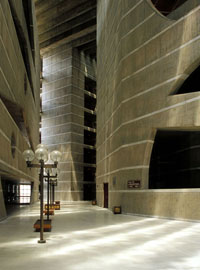
by Noy Hildebrand
It synchronises our biological rhythms with Earth’s daily rotation. Our eyes have evolved to sense it. It’s easily accessible, yet its significance is not fully understood by many. It can be easily identified and experienced, yet just as easily taken for granted. Those deprived of it probably understand this most. It is daylight.
Why does daylight matter? This form of energy has the capacity to physically, chemically and biologically impact living beings, including humans. The word biophillia is one way to describe the love of life and the qualities that characterise it. From the biophillic view, many life qualities directly relate to light:
- Humans and other forms of life respond to light as a stimulus. Short term, light can aid visual legibility, the search for resources and the avoidance of danger. Longer term, the various daylight qualities and sensations can be a very pleasant experience, as evident from the many sunset landscape photos

Daylight in the forecourt of Robin Boyd’s Walsh Street House. (Image: Rob Deutscher, CC BY 2.0) around.
- The circadian clock is a homeostatic regulatory feedback system within people and other living beings that is influenced by primarily light and other external factors. In humans, this can be described as physiological changes over a roughly 24-hour cycle that repeats over successive days. This can be measured in the level of some hormones in our saliva, such as melatonin, cortisol, leptin and ghrelin.
The absence of daylight can be associated with disruptions in sleep, metabolism, alertness, cognition and other physiological functions. Longer term disruptions to sleep have been linked to other ailments like cancer.
For the workplace, daylight is more appropriate than direct sunlight. What’s the difference? Daylight is essentially sunlight moderated by setting, or as as daylight enthusiast and architect Antony DiMase aptly describes, it is ‘a combination of sunlight, air, weather, time and place’. Since it is freely available during most business hours, daylight should be on the radar of anyone who is interested in passive, ‘free running’ built environments; these can be any environment from open space outdoor café seating to workplaces to living areas. A beautifully daylit space is a notable characteristic shared by many great buildings and rooms, such as Kahn’s National Parliament House in Dhaka and the Great Hall at the National Gallery of Victoria, amongst others.

Life-affirming light in the workplace
Think of a familiar workplace – only with no electric lights turned on. Could you walk around safely? Would it still be functional? Could you still perform tasks? We know that daylighting can contribute to energy savings and connect occupants to the outdoors. So why aren’t more workplaces daylit? The knowledgeable people at BuildingGreen describe it well:
‘Daylight has immense power that’s easy to lose control of … Even in some of the highest-profile green buildings designed … we hear story after story of glare, overheating, loss of productivity, and the most damning of all: blinds always down and lights always on. Re-learning how to use natural light in our buildings may be more difficult than we anticipated … While daylighting is as old as architecture itself, we must invent new strategies to respond to these new circumstances.’
What design can do
It is not always easy to design with daylight and especially to do it well. The authors of Tips for daylighting with windows suggest designers adopt ‘a holistic design approach, where the building is viewed as a whole and not just a collection of parts. Common practice often fails to address the critical interactions between the building façade (which admits heat and light) and the electric lighting system, resulting in an uncomfortable and inefficient building that is expensive and difficult to retrofit.’ From experience, the thresholds of an aperture are also important – so for windows this means both the frame and any surfaces near the window head, jambs and sill. And of course, the quality and quantity of light should be suitable for the main tasks in a space.
Here are some favourites from Tips for daylighting:
- Increase exposure to daylight – higher windows result in a deeper daylit zone
- Shape building for self-shading, noting that large windows need more control
- Take a ‘deep façade’ approach
- Capitalise on other building elements, i.e. gutters, cross bracing, etc. to integrate shading
- Use separate apertures for view, light and air
- Use horizontal window shapes
- Locate windows near room surfaces like ceilings, walls, beams for good distribution
- Distinguish between the control of glare (sun/sky brightness) and shading to control heat gain
Even if a project team structure is not embodying an integrated design approach, it may be worth having an honest chat about façade and window design with team members, consultants and contractors, to check the potential for collaborative input. This can lead to synergistic decisions that address multiple issues. It is often these types of design decisions that are harder to ‘value manage’ out.
Further reading
- Tips for daylighting with windows: an integrated approach 2nd edition
- Daylight in an airport – EDG News March 2014 issue, see ‘From the editor’
- EDG News July 2013 issue, see ‘Light in buildings’
- DAYLIGHT & ARCHITECTURE magazine by VELUX group autumn 2014 issue 22 -SLEEP, WORK, LIVE
- Light and Heatlh | Lighting Research Center, Rensselaer Polytechnic Institute
- Human Centric Lighting Society
